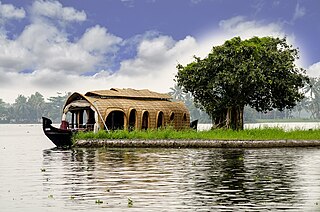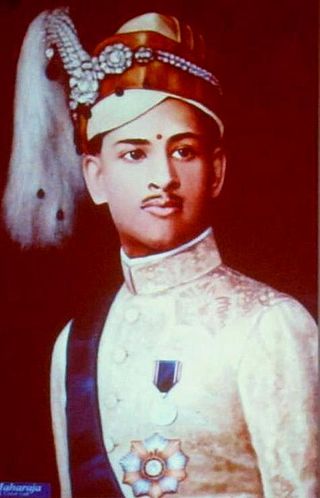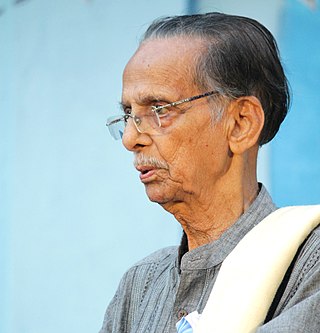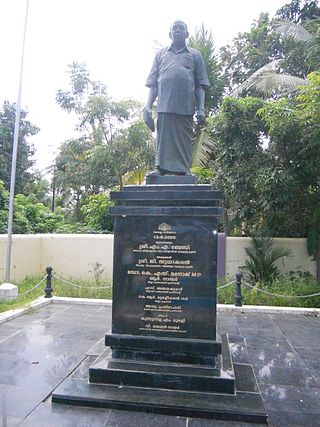Related Research Articles

Alappuzha district, is one of the 14 districts in the Indian state of Kerala. It was formed as Alleppey district on 17 August 1957, the name of the district being changed to Alappuzha in 1990. Alappuzha is the smallest district of Kerala. Alleppey town, the district headquarters, was renamed Alappuzha in 2012, even though the anglicised name is still commonly used to describe the town as well as the district.

Kottayam is one of 14 districts in the Indian state of Kerala. Kottayam district comprises six municipal towns: Kottayam, Changanassery, Pala, Erattupetta, Ettumanoor, and Vaikom. It is the only district in Kerala that does not border either the Arabian Sea or another Indian state.

The Kingdom of Travancore, also known as the Kingdom of Thiruvithamkoor or later as Travancore State, was an Indian kingdom that lasted from c. 1729 until 1949. It was ruled by the Travancore Royal Family from Padmanabhapuram, and later Thiruvananthapuram. At its zenith, the kingdom covered most of the south of modern-day Kerala and the southernmost part of modern-day Tamil Nadu with the Thachudaya Kaimal's enclave of Irinjalakuda Koodalmanikyam temple in the neighbouring Kingdom of Cochin. However Tangasseri area of Kollam city and Anchuthengu near Attingal in Thiruvananthapuram were parts of British India.

Sree Padmanabhadasa Sree Chithira Thirunal Balarama Varma, popularly known as Sree Chithira Thirunal, was the last ruling Maharaja of the Indian princely state of Travancore, in southern India until 1949 and later the Titular Maharajah of Travancore until 1991. His reign is known for several notable reforms that have indelible impact on the society and culture of Kerala.

University of Kerala, formerly the University of Travancore, is a state-run public university in Thiruvananthapuram, the state capital of Kerala, India. It was established in 1937 by a promulgation of the Maharajah of Travancore, Chithira Thirunal Balarama Varma who was also the first Chancellor of the university. C. P. Ramaswamy Iyer, the then Diwan of the State was the first Vice-Chancellor. It was the first university in Kerala, and among the first in the country. Accredited by NAAC with highest grade of A++ and scored 3.67 points out of 4.

The Kerala backwaters are a network of brackish lagoons and canals lying parallel to the Arabian Sea of the Malabar coast of Kerala state in south-western India. It also includes interconnected lakes, rivers, and inlets, a labyrinthine system formed by more than 900 km (560 mi) of waterways, and sometimes compared to bayous. The network includes five large lakes linked by canals, both man made and natural, fed by 38 rivers, and extending virtually half the length of Kerala state. The backwaters were formed by the action of waves and shore currents creating low barrier islands across the mouths of the many rivers flowing down from the Western Ghats range. In the midst of this landscape there are a number of towns and cities, which serve as the starting and end points of backwater cruises. There are 34 backwaters in Kerala. Out of it, 27 are located either closer to Arabian Sea or parallel to the sea. The remaining 7 are inland navigation routes.

Kuttanad is a region covering the Alappuzha, Kottayam and Pathanamthitta Districts, in the state of Kerala, India, well known for its vast paddy fields and geographical peculiarities. The region has the lowest altitude in India, and is one of the few places in the world where farming is carried on around 1.2 to 3.0 metres below sea level. Kuttanad is historically important in the ancient history of South India and is the major rice producer in the state. Farmers of Kuttanad are famous for Biosaline Farming. Food and Agriculture Organization (FAO) has declared the Kuttanad Farming System as a Globally Important Agricultural Heritage System (GIAHS) in 2013.

Kavalam is a village in Kuttanadu, Kerala state, Alappuzha District. India.

Thiruvananthapuram District is the southernmost district in the Indian state of Kerala. The district was created in 1949, with its headquarters in the city of Thiruvananthapuram, which is also Kerala's administrative centre. The present district was created in 1956 by separating the four southernmost Taluks of the erstwhile district to form Kanyakumari district. The city of Thiruvananthapuram is also known as the Information technology capital of the State, since it is home to the first and largest IT park in India, Technopark, established in 1990. The district is home to more than 9% of total population of the state.

The Liberation Struggle in Kerala (1958–59) was a period of anticommunist protest against the first elected state government in Kerala, India, which was led by E. M. S. Namboodiripad of the Communist Party of India. Organised opposition to the state government was spearheaded by the Syro-Malabar Church, the Nair Service Society, the Indian Union Muslim League, and Indian National Congress. The Communists believed the movement received funds mostly from outside of India, mobilised by the CIA and international Catholic organisations. In the aftermath of "liberation struggle", at least 15 people mostly Christians including a pregnant woman are recorded to be dead from various police firings and at the hands of communist workers. Following mass protests and deaths from police firing, in 1959, the Indian government finally bowed to pressure and dismissed Namboodiripad on 31 July 1959.

Alappuzha, also known as Alleppey, is a municipality in the Alappuzha district of Kerala, India. It is the district headquarters of the district, and is located about 130 km (80.8 mi) north of the state capital Thiruvananthapuram. As per the 2011 Indian census, Alappuzha has a population of 240,991 people, and a population density of 3,675/km2 (9,520/sq mi).

Kottayam is a city in the Kottayam district of Kerala, India. It is the district headquarters of the district and is located about 151 km (93.8 mi) north of the state capital Thiruvananthapuram. As per the 2011 Indian census, Kottayam has a population of 489,615 people, and a population density of 4,533/km2 (11,740/sq mi). The total Kottayam Metropolitan area has a population of 802,419 people, and a population density of 3,647/km2 (9,450/sq mi).

Kavalam Narayana Panikkar was an Indian dramatist, theatre director, and poet. He has written over 26 Malayalam plays, many adapted from classical Sanskrit drama and Shakespeare, notably Kalidasa's Vikramorvasiyam, Shakuntalam (1982), Bhasa's Madhyamavyayogam (1979), Karnabharam, Uru Bhangam (1988), Swapnavasavadattam, and Dootavakyam (1996). He was the founder – director of theatre troupe, Sopanam, which led to the foundation of Bhashabharati: Centre for Performing Arts, Training and Research, in Trivandrum.
Mankombu or Moncombu is a village in the district of Alappuzha in the state of Kerala, India. Monkombu, part of the Kuttanad delta region popularly mentioned as 'Rice bowl of Kerala'; is one of the major paddy cultivation regions of the state. Its unique geography embodied by Vembanad lake, inter-linked Pambaa, Manimala and Achenkovil river systems, gives rise to islands, back waters, network of waterways and canals, below sea-level paddy fields and marsh. The farmers here have met the challenges of below sea-level cultivation over two centuries. Annual festivals, auspicious rites and religious events at Mankombu Bhagavathi Devi temple, St.Pius church and Pope John Paul Church are occasions for social communion, rejoicing and celebration. Once a prosperous hamlet of hundreds of households, Mankombu today is ravaged by climate change, pollution and dwindling population.

Media in Kerala, India are widely accessible and cater to a wide variety of audiences. Kerala has the highest media exposure in India with newspapers publishing in nine languages, mainly English and Malayalam.

Thakazhy is a village in Alappuzha district in the Indian state of Kerala. It is part of the Kuttanad region bound by the backwaters and is located on the banks of the River Pamba. It is the birthplace of the famous writer Thakazhi Sivasankara Pillai, who was popularly known just by his village name. There is a small temple called Ennavalyachan to the back side of the famous Dharma sastha temple which is the second famous ayyappa temple after sabarimala.
Kayamkulam Kochunni was a heroic outlaw from Kayamkulam, who lived during the late 19th century. He was active in the Travancore area in the present-day Kerala, India. He is said to have stolen from the rich and given to the poor. Legends on his life are part of the folklore of Kerala. His stories are often associated with his friend and fellow outlaw Ithikkara Pakki. A shrine dedicated to Kochunni exist in near Kozhencherry.

The following outline is provided as an overview of and topical guide to Kerala:

Thomas Chandy was an Indian businessman and politician. He was a member of the Kerala Legislative Assembly from the Kuttanad constituency, the transport minister of the state of Kerala, and president of the Nationalist Congress Party in Kerala. He resigned from the minister's office on 15 November 2017 after an allegation regarding his resort in Alappuzha arose. He died in Kochi on 20 December 2019 from cancer.

St. Mary's Forane Church, Pulinkunnoo is a Catholic church located in Alappuzha district of Kerala, India. Located in a small village named Pulinkunnoo in Kuttanad, the church is also known as Pulinkunnoo church or Pulinkunnu church. It is one of the oldest church and Christian pilgrim centre in Alappuzha district.
References
- 1 2 3 4 5 6 7 8 Joseph, Reji. "കായൽ രാജാവ് മുരിക്കൻ-പുനർവായന". www.deepika.com.
- 1 2 3 "The Man who Created 'Paradise' in Western Ghats". The New Indian Express.
- 1 2 3 4 5 "കായൽ നികത്തൽ-ജോസഫ് മുരിക്കൻ മുതൽ തോമസ് ചാണ്ടി വരെ". Indian Express Malayalam (in Malayalam). The Indian Express. 15 November 2017.
- 1 2 3 4 5 "ചിറകെട്ടി മുരിക്കനുണ്ടാക്കിയ കര! ഇന്നും വണ്ടി കടന്നുചെല്ലാത്ത കൈനകരിയിലേക്ക് ഈ യാത്ര | exploring kuttanad | kuttanad kainakari travel | kuttanad attractions". vanitha.in. Vanitha.
- ↑ Tharamangalam, Joseph (1 November 2011). Agrarian Class Conflict. UBC Press. ISBN 978-0-7748-4447-5.
- ↑ "The Thomas Chandy episode: End of old school values in Kerala politics?". The News Minute. 18 November 2017.
- ↑ "A peak into Murickan's enchanting Kuttanad". OnManorama.
- 1 2 3 "മുരിക്കന്റെ ശുദ്ധജലം നൽകുന്ന കുളം, ജലശാസ്ത്ര വിസ്മയം!". ManoramaOnline.
- 1 2 3 4 5 M. G., Radhakrishnan (3 September 2011). "Kerala: CPI(M) wants a chapter in a school textbook deleted for ridiculing its role". India Today.